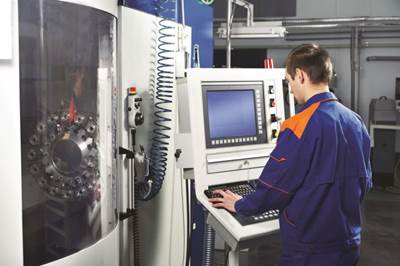Articles
Supercritical Success for Medical Machining
High-pressure carbon dioxide coolant can dramatically improve the production rate of titanium parts while leaving no residue — an excellent fit for medical machining.
Read MoreBuilding Out a Foundation for Student Machinists
Autodesk and Haas have teamed up to produce an introductory course for students that covers the basics of CAD, CAM and CNC while providing them with a portfolio part.
Read MoreCNC Machines, Wyoming Monks, and Enduring Works of Gothic Art
The Carmelite monks of Wyoming adopted CNC machining to help build a monastery that, without this technology, would take decades or longer to complete. How they are doing it is fascinating. But so is why.
Read MoreTactile Sensor Could Give Robots Human Touch
Gelsight’s tactile sensing technology could give robots more flexibility in the tasks and environments they can handle.
Read MoreHow to Automate a Prototyping Shop
By focusing machine tending on pallets rather than individual parts, KAD Models has automated its high-mix, low-volume workload — and thrived as a result.
Read MoreInside a CNC-Machined Gothic Monastery in Wyoming
An inside look into the Carmelite Monks of Wyoming, who are combining centuries-old Gothic architectural principles with modern CNC machining to build a monastery in the mountains of Wyoming.
Read MoreThe Final CNC Tech Talk Column
Mike Lynch signs off on his CNC Tech Talk column after 35 years.
Read MoreHow I Made It: Mike Lynch
Mike Lynch has been a CNC programming teacher for three decades, in addition to being the longest-running columnist in 91ÊÓƵÍøÕ¾ÎÛ history, providing generations of machinists with expert insight into the art of programming parts. With this issue being Mike’s last, we wanted to highlight his career and what it means for the industry.
Read MoreHow to Mitigate Risk in Your Manufacturing Process or Design
Use a Failure Mode and Effect Analysis (FMEA) form as a proactive way to evaluate a manufacturing process or design.
Read MoreHow to Determine the Currently Active Work Offset Number
Determining the currently active work offset number is practical when the program zero point is changing between workpieces in a production run.
Read MoreBuilding Temperature Compensation Into the Gaging Station
As production tolerances become ever tighter and the error margin for measurement results shrinks, manufacturers must consider thermal fluctuations in their inspection processes.
Read MoreThree Key Factors For Stabilizing a Grinding Operation
Improving throughput in grinding takes more than direct increases to material removal rate. It also requires careful consideration of the factors behind the operation’s stability.
Read More










